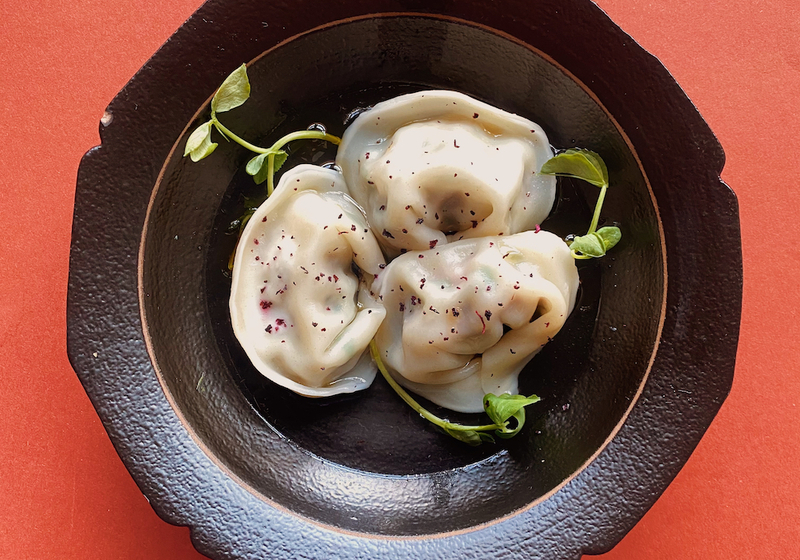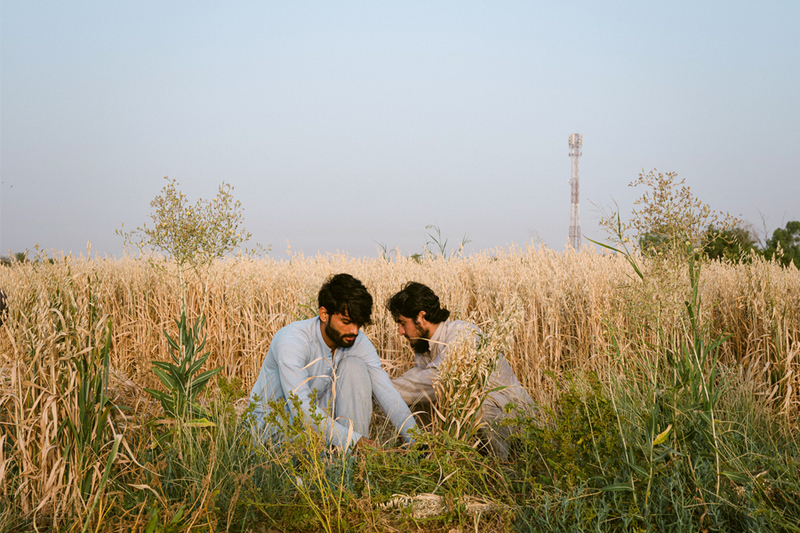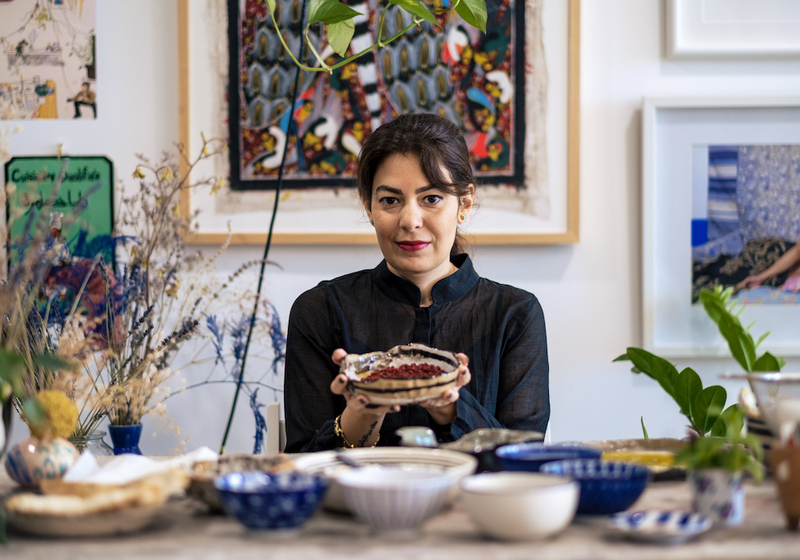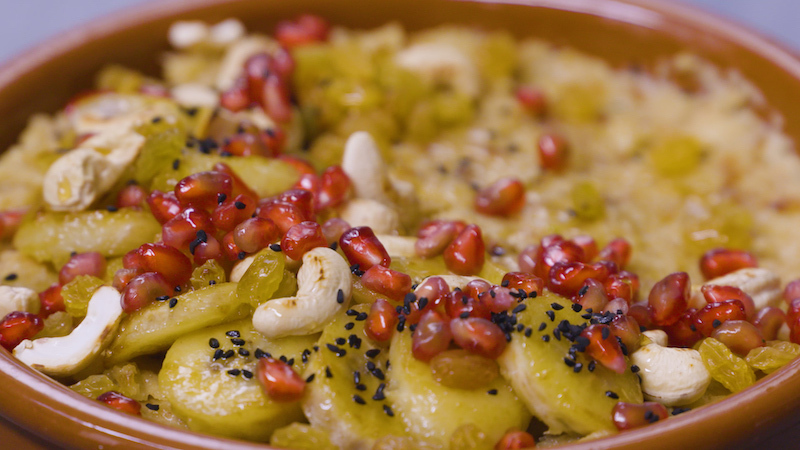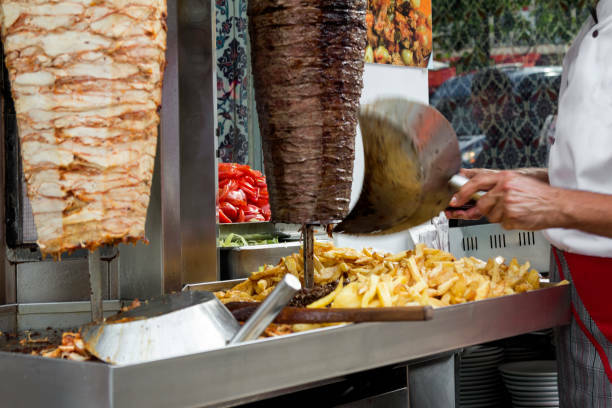
Photography by Anton Stüber
Germany-based publishing house Kerber Verlag has produced the book “The Videoart at Midnight Artists’ Cookbook”, which features the favorite recipes of eighty artists, some simple, others elaborate, but all with a personal story.
The book was produced by art dealer, curator, and publisher Olaf Stüber (in cooperation with his son Anton Stüber), who has been part of the international Berlin art community for more than twenty years.
“I have always been passionate about cooking at home for family and friends. Many new ideas and projects have developed from this. I also often cooked with artists in my gallery, which I ran in Berlin for several years. We would dine until the wee hours, tables bending, and sometimes a collector would buy something in the middle of the night. But I also enjoy being cooked for and being surprised by artists with their creations from the stove,” writes Olaf Stüber.
The original idea started with Videoart at Midnight—monthly gatherings of artists presenting their works on the big screen of the legendary Babylon cinema in Berlin-Mitte. Subsequently it developed into a huge festival with over a hundred participants: “An art event is ephemeral. We all wished for something shareable and lasting—a book, not as a medium to depict film and video, but as a continued dialog with the artists.”
EastEast is publishing selected extracts from the book with the favourite recipes of Harun Farocki, Shahram Entekhabi, Monira Al Qadiri, and Almagul Menlibayeva. “Perhaps one dish or the other will bring you closer to an artist and spike your curiosity about art, possibly becoming the starting point for a further conversation, hopefully over a meal and a glass of wine.”
BY ANTJE EHMANN FOR HARUN FAROCKI

Photography by Anton Stüber
Farun Farocki was born as Harun El Usman Faroqhi in Neutitschein, Sudetenland (now Nový Jicín, Czech Republic) in 1944, grew up in India and present-day Indonesia, later in Bad Godesberg, and finally, from 1958 on, in Hamburg. He lived in Berlin until his death in 2014. He is considered one of the most important and internationally influential German filmmakers and video artists. His oeuvre includes more than one-hundred experimental and documentary, essay, short, and feature films. From 1998 on he lived and worked with curator and artist Antje Ehmann, born in Gelsenkirchen (Germany) in 1968. Antje Ehmann is the author of the provided recipe.
During one of our stays in India, we—Harun Farocki and I—were invited to dinner by our friend Vasanthi in Bangalore. We had a delicious chicken biryani. We talked at length about the pleasure of cooking, about spices, vegetables you can’t get in Europe, and about the challenge—an endless life-long task—of preparing a perfect chicken biryani. I love this idea of trying something over and over again on the way to perfection (without certainty).
However, for this book project I suggest a dal recipe. Which is also a life task. You can prepare dals in innumerous ways. Harun loved all my dals! Recently, however, my friend Ruchir from Calcutta and I prepared a dal that was so delicious that I was afraid I had one life task less. Highly recommended!

Prepping the lentils: First, put the lentils in a large bowl and wash them with cold water until no more white foam emerges (work through with your hands, drain the cloudy water several times through a sieve, refill, and so on). You can also leave the lentils to soak in water for an hour beforehand.
The recipe: You need a large, heavy pot with a lid (dal has to breathe while cooking). Fill with lentils and twice the amount of water and bring to a boil on a high flame. As soon as the water comes to the boil, reduce the heat and continuously skim off the white froth that emerges.
Wash the cilantro, remove only the roots, chop coarsely. Chop the green chilies coarsely, too. Peel and finely chop the ginger and garlic. Puree everything with half a cup of water in a blender until you have a paste. Grind the cumin and coriander seeds until you have a powder in a mortar and season the dal with it, also adding turmeric, chili powder, sugar, and salt, and stir in the paste.
Put the lid on loosely (with a small crack for breathing). Let simmer on a low flame, stirring occasionally, so it doesn’t burn. When the lentils are soft, add the tamarind paste.
Heat 3 tablespoons of rapeseed oil in a small pan, toast the asafoetida in it until you can smell it, add cloves and mustard seeds. Mix into the dal.
Theoretically, the dal can be served once the lentils dissolve. But the longer it cooks, the more flavors it develops. It tastes best the next day! The lentils must be soft. Season with salt and brown sugar if necessary.
You can serve the dal with rice for a main course or with roti, nan or batura as a starter.
Fesenjan
BY SHAHRAM ENTEKHABI

Photography by Anton Stüber
Shahram Entekhabi was born in Borujerd, one of Iran’s oldest cities, in 1963 and has been living in Berlin since 1982. He is interested in social ideas and assumptions about urban spaces. Questions of visibility and invisibility in relation to masculinity and marginality play a central role in his practice.
Fesenjan is a delicious and nutritious dish that has been cooked in Iran for over 2500 years. In the ancient ruins of Persepolis, archaeologists discovered a plate that listed the ingredients. Since this dish is very tasty, it has never been altered. Fesanjan is cooked at the end of winter and the arrival of spring. This is why it is the official Nowruz dish, the Persian New Year. Already the Persian’s ancestors insisted on celebrating Nowruz with fesenjan. It is also one of the dishes often served at wedding ceremonies in Iran. To me, fesenjan represents childhood. I have spent more than half of my life in Europe, first in Italy, then in Berlin. My diet has of course been enriched immensely as a result. But the taste of fesenjan remains incomparable, it is so familiar, a feeling as if the palate were being cradled at home.

Heat the oven to 350 °F. Evenly spread the walnuts on a baking tray and toast for about 15 minutes. Remove from the oven and let cool completely, then transfer to a food processor. Blend until well ground but not quite buttery yet. Meanwhile, heat the oil and butter in a large saucepan over medium-high heat. Season the chicken all over with salt and sear, turning as needed, until golden, 6 to 8 minutes. Transfer to a plate. Add the onions, cut into thin rings, and more oil if needed, caramelize until lightly golden and tender, 5 minutes. Transfer to the plate with the chicken.
Add the ground walnuts to the saucepan along with the pomegranate molasses and 3 1/2 cups water. Bring to a boil, reduce the heat to maintain a simmer, and cook, stirring occasionally, until thick, about 2 hours. Add the reserved chicken and onions and cover. Continue to cook, stirring occasionally, until the chicken is very tender, about 1 more hour. Season with salt and cinnamon and top with pomegranate seeds.
Serve with cooked Persian rice.
Goya Champuru
BY MONIRA AL QADIRI

Photography by Anton Stüber
Monira Al Qadiri is a Kuwaiti artist who was born in Dakar (Senegal) in 1983, received her training in Japan and has been living in Berlin since 2018. In her work she deals with the aesthetics of sadness in the Middle East, from poetry, music, art, and religious practices to gender identities and their disruption as a consequence of prosperity, the globalized world, religious beliefs, and magical thinking.
I chose this recipe because Japanese cuisine is so famous on the world stage, yet no-one outside Japan knows much about Okinawan food, which has a completely separate cultural and historical background.
Okinawa—often referred to as the Island of the Centenarians, because nowhere else people get olderget olderHara Hachi Bu—“Eat until you are eight parts full” is a Confucian maxim according to which you should only eat until you are eighty percent full. The inhabitants of Okinawa, who have been following this special form of mindful and conscious eating for many generations, don’t struggle with obesity and become very old.—is still considered by some to be a colony of Japan, a place with a different language, culture, and of course with a different cuisine.
Goya champuru is a very popular dish in Okinawa, although goya is a type of cucumber with a rather bitter taste of its own. If you have trouble finding it, ask for bitter cucumber or bitter melon. With this recipe, I wanted to highlight this special and ancient place and its people.
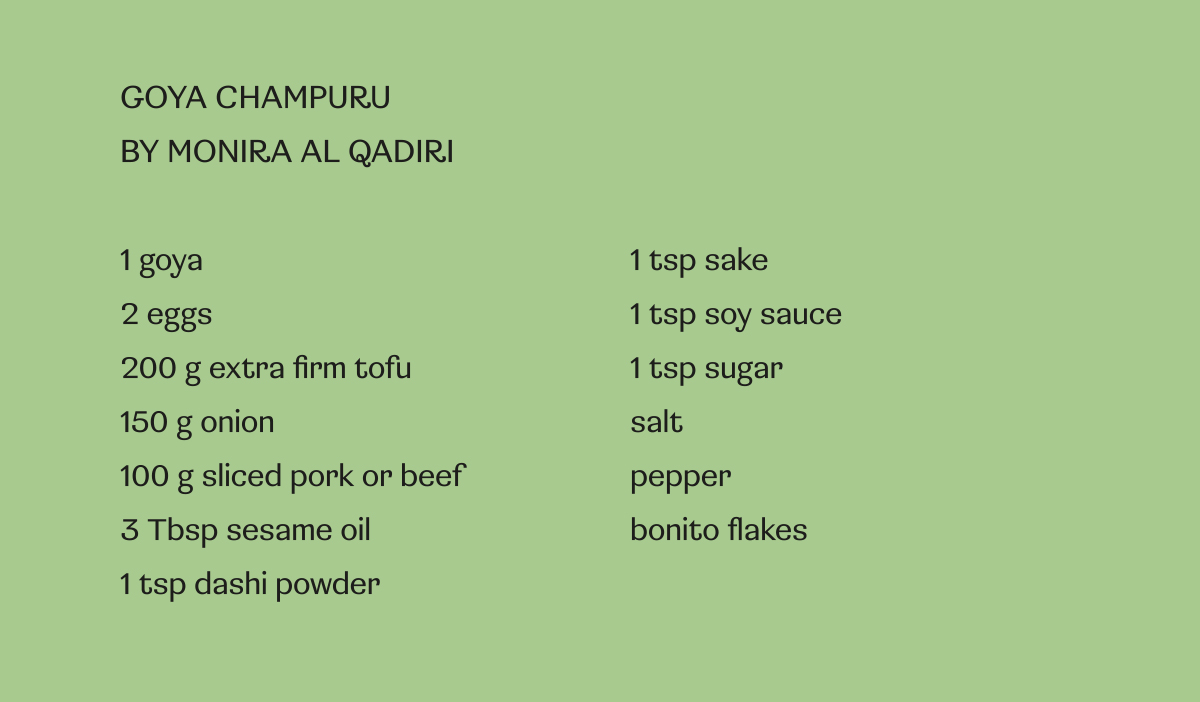
Cut the goya in half and scoop out all the inner white pith and seeds, basically just leaving the outer shell. Slice the goya, then boil it in salt water for a few minutes to soften. The salt helps neutralize the bitterness.
Slice the meat thinly, place it in sake, soy sauce, sugar, and dashi powder and leave to rest.
Put 2 tablespoons of sesame oil into a wok or pan and heat. Drain the tofu first with paper towels, then stir-fry for a few minutes until brown. Remove from the pan.
Beat the eggs in a bowl, pour 1 tablespoon of hot sesame oil into a pan, pour in the eggs and allow to set very lightly. They must not coagulate.
Fry the meat in some oil, add the onion cut into fine rings and the slices of bitter cucumber and sauté briefly. When the meat is cooked, add the tofu and carefully fold in the eggs. Season with dashi powder and pepper. Serve hot. Sprinkle with bonito flakes for flavor.
Red Velvet Cakes
BY ALMAGUL MENLIBAYEVA

Photography by Anton Stüber
Almagul Menlibayeva was born in Almaty (Kazakhstan) in 1969 and has been based in Berlin since 2007. In her work she critically investigates Soviet modernity, the social, economic, and political transformations in post-Soviet Central Asia, and the decolonialist reinterpretation of gender, environmental destruction, and Eurasian nomadic and indigenous cosmologies and mythologies.
I would like to share a recipe here that I have never actually prepared and never tasted. In the 1990s, I introduced a close friend to a famous sculptor from Almaty. He invited us to his studio for tea and cake. I arrived early and the artist went to meet my friend at the bus stop, as he was afraid she wouldn’t find the house. “I’m scared of your dog!”, I said to the artist. “He’s friendly!”, he replied and disappeared through the front door. Since my childhood I had been afraid of guard dogs. There was silence. A triangular relationship between the delicious red velvet cakes, the dog, and myself began to develop. The dog with the short legs pressed his body against the table. It began to topple. The first cakes, decorated with white creamy roses, fell onto the floor and disappeared between my new friend’s infamous jaws. Someone had once told me about the powerful jaw muscles of bull terriers. The dog burped in my face, pushed his nose against my foot, opened his jaws, and bumped against the table again. The cakes and I lost. He devoured the balance of the red velvet cakes which he had managed to push off the table. It smelled like the feast of a satisfied but still greedy canine. I was already on the table by then. “Did you leave us any cakes?”, my friends asked when they returned to the studio. “Sure, lots of cake …” Yum, yum …

For the dough: Preheat the oven to 350 °F and prepare the muffin tray by lining it withpaper cups in the wells. Mix the oil, eggs, buttermilk, vinegar, and vanilla with a whisk attachment at medium speed, add the sugar and mix in. Add the cocoa powder, salt, and baking powder, and mix at medium speed for 30 seconds until there are no more lumps. Set the mixer to low speed and add the flour and red food coloring. Stir the mixture until it is smooth. Fill the dough evenly into the prepared baking tin and bake for 25 to 30 minutes or until a toothpick inserted in the middle of the sample remains clean when pulled out. First let the cakes cool in the tin for 10 minutes, then remove them and let them cool completely on a wire rack.
For the icing: Mix the milk, flour, and salt in a small pot at low to medium heat until the mixture thickens to the consistency of a very thick sauce. Remove the saucepan from the heat and allow to cool completely, stirring occasionally. Beat the butter with the icing sugar for 1 minute, or until creamy, using a mixer. Add the cooled flour mixture and vanilla extract. Stir at medium speed for 2 to 3 minutes until the icing becomes thick and smooth. Fill the icing into a piping bag and decorate the cakes with it.
The Videoart at Midnight Artists’ Cookbook
September 2020
ISBN 978-3-7356-0725-6
22 × 26 cm, 256 Pages, 190 colored illustrations, Hardcover
Languages: English
Editor: Olaf Stüber & Anton Stüber, Videoart at Midnight
Design by Jörg Adam, Adayto, Berlin
